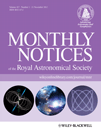Global gravitationally organized spiral waves and the structure of NGC 5247
S. A. Khoperskov
Institute of Astronomy, Russian Academy of Sciences, Pyatnitskaya st. 48, 119017 Moscow, Russia
Search for more papers by this authorA. V. Khoperskov
Volgograd State University, Universitesky pr. 100, 400062 Volgograd, Russia
Search for more papers by this authorI. S. Khrykin
Physics Department, Southern Federal University, Zorge st. 5, 344090 Rostov-on-Don, Russia
Search for more papers by this authorCorresponding Author
V. I. Korchagin
Institute of Physics, Southern Federal University, Stachki st. 124, 344090 Rostov-on-Don, Russia
E-mail: [email protected]Search for more papers by this authorD. I. Casetti-Dinescu
Astronomy Department, Yale University, New Haven, CT, 06520-8101 USA
Search for more papers by this authorT. Girard
Astronomy Department, Yale University, New Haven, CT, 06520-8101 USA
Search for more papers by this authorW. van Altena
Astronomy Department, Yale University, New Haven, CT, 06520-8101 USA
Search for more papers by this authorD. Maitra
Department of Astronomy, Univ. of Michigan, 500 Church St., Ann Arbor, MI, 48109-1042 USA
Search for more papers by this authorS. A. Khoperskov
Institute of Astronomy, Russian Academy of Sciences, Pyatnitskaya st. 48, 119017 Moscow, Russia
Search for more papers by this authorA. V. Khoperskov
Volgograd State University, Universitesky pr. 100, 400062 Volgograd, Russia
Search for more papers by this authorI. S. Khrykin
Physics Department, Southern Federal University, Zorge st. 5, 344090 Rostov-on-Don, Russia
Search for more papers by this authorCorresponding Author
V. I. Korchagin
Institute of Physics, Southern Federal University, Stachki st. 124, 344090 Rostov-on-Don, Russia
E-mail: [email protected]Search for more papers by this authorD. I. Casetti-Dinescu
Astronomy Department, Yale University, New Haven, CT, 06520-8101 USA
Search for more papers by this authorT. Girard
Astronomy Department, Yale University, New Haven, CT, 06520-8101 USA
Search for more papers by this authorW. van Altena
Astronomy Department, Yale University, New Haven, CT, 06520-8101 USA
Search for more papers by this authorD. Maitra
Department of Astronomy, Univ. of Michigan, 500 Church St., Ann Arbor, MI, 48109-1042 USA
Search for more papers by this authorABSTRACT
Using observational data, we build numerical N-body, hydrodynamical and combined equilibrium models for the spiral galaxy NGC 5247. The models turn out to be unstable as regards spiral structure formation. We simulate scenarios of spiral structure formation for different sets of equilibrium rotation curves, radial velocity-dispersion profiles and disc thicknesses and demonstrate that in all cases the simulated spiral pattern agrees qualitatively with the observed morphology of NGC 5247. We also demonstrate that an admixture of a gaseous component with a mass of about a few per cent of the total mass of the disc increases the lifetime of a spiral pattern by approximately 30 per cent. The simulated spiral pattern in this case lasts for about 3 Gyr from the beginning of the growth of perturbations.
REFERENCES
- Barnes J., Hut P. A., 1986, Nat, 324, 446
- Bertin G., Lin C. C., 1996, Spiral Structure in Galaxies: A Density Wave Theory. MIT Press, Cambridge, MA, p. 271
- Bertin G., Lin C. C., Lowe S. A., Thurstans R. P., 1989a, ApJ, 338, 78
- Bertin G., Lin C. C., Lowe S. A., Thurstans R. P., 1989b, ApJ, 338, 104
- Bottema R., 1993, A&A, 275, 16
- Buta R. J., Knapen J. H., Elmegreen B. G., Salo H., Laurikainen E., Elmegreen D. M., Puerari I., Block D. L., 2009, AJ, 137, 4487
- Considere S., Athanassoula E., 1988, A&AS, 76, 365
- Contopoulos G., Grosbol P., 1986, A&A, 155, 11
- Elmegreen B. G., Thomasson M., 1993, A&A, 272, 37
- Elmegreen D. M. et al., 2011, ApJ, 737, 32
- Eskridge P. et al., 2002, ApJS, 143, 73
- Fux R., 1999, A&A, 345, 787
- Gerola H., Seiden P. E., 1978, ApJ, 223, 129
- Hunter C., 1979, ApJ, 227, 73
- Kaufmann D. E., Contopoulos G., 1996, A&A, 309, 381
- Kendall S., Kennicutt R. C., Clarke C., 2011, MNRAS, 414, 538
- Khoperskov A. V., Just A., Korchagin V. I., Jalali M. A., 2007, A&A, 473, 31
- Khoperskov A., Bizyaev D., Tiurina N., Butenko M., 2010, Astron. Nachr., 331, 731
- Khoperskov S. A., Khoperskov A. V., Eremin M. A., Butenko M. A., 2011, Astron. Lett., 37, 563
- Kikuchi N., Korchagin V., Miyama S. M., 1997, ApJ, 478, 446
- Korchagin V. I., Shevelev Yu. G., 1981, Astrophys., 17, 254
10.1007/BF01005586 Google Scholar
- Korchagin V., Kikuchi N., Miyama S. M., Orlova N., Peterson B. A., 2000, ApJ, 541, 565
- Korchagin V., Orlova N., Kikuchi N., Miyama S. M., Moiseev A. V., 2005, preprint (astro-ph/0509708)
- Laughlin G., Korchagin V., Adams F. C., 1997, ApJ, 477, 410
- Marochnik L. S., 1966, AZh, 43, 919
- Marochnik L. S., Mishurov Yu. N., Suchkov A. A., 1972, Ap&SS, 19, 285
- Patsis P. A., Grosbol P., Hiotelis N., 1997, A&A, 323, 762
- Paturel G., Petit C., Prugniel Ph., Theureau G., Rousseau J., Brouty M., Dubois P., Cambresy L., 2003, A&A, 412, 45
- Roberts W. W., 1969, ApJ, 158, 123
- Romeo A. B., Wiegert J., 2011, MNRAS, 416, 1191
- Sellwood J. A., 2011, MNRAS, 410, 1637
- Semelin B., Combes F., 2002, A&A, 388, 826
- Sygnet J. F., Pellat R., Tagger M., 1987, Phys. Fluids, 30, 1052
- Thomasson M., Elmegreen B. G., Donner K. J., Sundelius B., 1990, ApJ, 356, 9
- Toomre A., 1981, Proceedings of the Advanced Study Institute. Cambridge Univ. Press, Cambridge, p. 111
- van der Kruit P. C., Freeman K. C., 1986, ApJ, 303, 556
- van Leer B., 1979, J. Comput. Phys., 32, 101
- Vauterin P., Dejonghe H., 1996, A&A, 313, 465
- Wada K., Koda J., 2004, MNRAS, 349, 270
- Wang B., Silk J., 1994, ApJ, 427, 759
- Zhang H., 1996, ApJ, 457, 125
- Zhang H., 1998, ApJ, 499, 93
- Zhang H., 1999, ApJ, 518, 613
- Zhao Y., Peng Q., Wang L., 2004, Chin. J. Astron. Astrophys., 4, 51
- Zhao Y., Peng Q., Hu T., 2006, A&A, 452, 451




